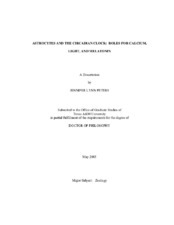| dc.description.abstract | Melatonin is rhythmically synthesized and released by the pineal gland and, in some species, retina during the night and regulates many physiological and behavioral processes in birds and mammals. Chick diencephalic astrocytes express two melatonin receptor subtypes in vitro, and melatonin plays a role in regulating metabolic activity. We examined the role of glial cells in circadian function and asked if melatonin modulated glial functions within the retina and the brain. Calcium waves were potentiated by physiological concentrations of melatonin. Melatonin increased resting calcium levels and reduced gap junctional coupling among astrocytes at these same concentrations. Both mouse and chick diencephalic and telencephalic astrocytes express melatonin receptor protein. Nanomolar melatonin modulated astrocytic calcium waves of the mouse and chick diencephalon but not waves of the telencephalon. Mammalian intercellular calcium waves spread farther than avian calcium waves, and the nature of the spread of the waves differed between telencephalic and diencephalic mammalian astrocytes. These differences in propagation were abolished by melatonin. Using northern analysis, we identified period2, period3, cryptochrome1, cryptochrome2, clock, melanopsin and peropsin within chick diencephalic astrocytes. The clock genes cry1 and, per2 were expressed rhythmically in a LD cycle, but metabolic activity was not rhythmic. When cells were placed in constant darkness and rhythmically administrated melatonin, a robust rhythm in glucose uptake was induced without a coordinated clock gene rhythm, suggesting rhythmic clock gene expression and metabolic activity are separable processes. Melatonin affected visual function as assessed by electroretinogram. Circadian rhythms of a- and b-wave implicit times and amplitudes were observed. Melatonin (1 mg/kg and 100 ng/kg) decreased a- and b-wave amplitudes greater during the night than during the day and it increased a- and b-wave implicit times while 1 ng/kg melatonin had little to no effect over the saline controls. These data indicate that melatonin modulates glial intercellular communication, affects metabolic activity in astrocytes, and may play a role in regulating a day and night functional shift in the retina, at least partially through Müller glial cells. Thus, melatonin can regulate glia function and thereby, affect outputs of the vertebrate biological clock. | en |


